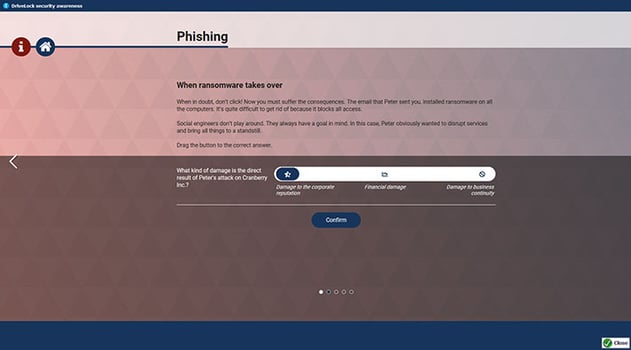Enforcing The Human Firewall: The Key to Preventing Cyber Attacks
While firewalls, antivirus software, and intrusion detection systems serve as essential security layers, human error remains the weakest link in...

More and more new malware variants and so-called fileless attack vectors threaten corporate networks. The AV-TEST Institute registers more than 450,000 new malware and potentially unwanted applications (PUA) every day. In 2021, it registered more than 1312 million malware variants, an average of more than 10 million new variants per month. In this post we will clarify definition of a cybersecurity awareness and why it is important. But also, our experts will give you some tipps on the contents of cybersecurity awaress trainings.
| TABLE OF CONTENT |
A cybersecurity awareness is an ongoing process of educating and training people who are working in any kind of organisations about possible cyber threads in day-to-day operations. Cybersecurity awareness also includes being aware of cyber dangers, threads prevention, and what to do in case your business is attacked. It includes being aware of latest cyber threads, best practices, and processing sensitive data.
Software vulnerabilities are being exploited in a targeted manner - check our blog post about the the Log4j hack. So, it is only logical to upgrade technical controls and defense mechanisms as much as possible to prevent the execution of malware, scan software versions for vulnerabilities, enable multi-level authentication, etc.
However, it would be too simplistic to see cyber defense purely as a technical challenge - people's actions play a significant role. The cause of security incidents is almost always human error. Large and complex systems are vulnerable to mistakes made by inexperienced or untrained staff, as well as to the activities of malicious insiders.
That's why, information security awareness training for all employees (including executives!) can help to build security awareness. It is also important that these trainings are not stand-alone, one-off special measures that only apply to the fulfillment of recommendations and standards.
Cybersecurity Awareness Month occurs every October from 2004 to raise awareness of staying safe and secure during online activities. During this month, many events are being supported not only by Cybersecurity & Infrastructure Security Agency or National Cybersecurity Alliance but also the European Union Agency for Cybersecurity to educate private individuals and organisations about improving their cybersecurity.

Let's look at an analogy for our early learning phases: Before we are allowed to drive a car, we have to pass a driving test. But we can drive safely on the road after sufficient driving practice, i.e. through constant repetition. One-off training is not enough. Applying to cyber security: We need warnings and repetition to build up security awareness. These 'pulses' should be timed to coincide with security-related activities - which could have precarious consequences if we are not highly focused. Ideally, IT security training is supported by or integrated into the IT security solution used.
Although human error can never be completely ruled out, well-planned cyber security awareness training helps to reduce the risk to an acceptable level. To raise awareness in the long term, it is essential to integrate a program of awareness-raising and training into everyday work.
Security awareness training for employees educates users on what they can do to detect malicious activity and how to act in the event of such activity. Security awareness training is an important layer of security added to existing 'technical' security controls.
A well-structured training program can drastically reduce the likelihood of human error, which is often the weakest link in any security framework. Below are the key components that make cybersecurity awareness training effective:
Tailored Content for Different Roles
Not all employees face the same cybersecurity risks. A successful training program should be customized to meet the needs of different departments and roles:
Basic training for general staff: Educate all employees on fundamental practices like password hygiene, phishing awareness, and safe internet usage.
Advanced training for IT and management: Train the IT department and executives on more complex topics like incident response, data encryption, and access control.
Role-specific scenarios: Sales teams, HR, and customer service departments should be given scenarios that apply to the type of data they handle or the threats they are most likely to encounter.
Interactive and Engaging Methods
One of the biggest challenges of cybersecurity awareness training is keeping employees engaged. The use of interactive and multimedia approaches can make a significant difference:
Simulated phishing attacks: Test employees by sending fake phishing emails and measure their responses. Offer instant feedback and further training if necessary.
Quizzes and games: Gamification helps make the training more enjoyable and memorable. For example, employees could take quizzes to reinforce key concepts and compete for rewards.
Scenario-based role-playing: Engage employees in mock cyber incidents where they have to make decisions about how to handle the situation. This improves critical thinking and practical application of the lessons learned.
Promoting a Security-First Culture
Cybersecurity awareness shouldn’t be treated as a one-time event but rather as part of the organizational culture. The training should:
Encourage reporting: Create an environment where employees feel comfortable reporting suspicious emails, potential breaches, or security lapses without fear of reprisal.
Leadership involvement: When senior management is actively involved in cybersecurity training, it demonstrates the importance of the issue to the entire organization. Leadership should model best practices by following the same rules they expect from employees.
Up-to-Date Threat Information
Cybersecurity is a constantly evolving field, and new threats emerge regularly. A successful training program should be:
Updated regularly: Make sure the content reflects the latest types of attacks (e.g., spear-phishing, deepfakes) and includes information on the latest security tools and policies.
Adaptable to emerging threats: Provide special sessions when new and significant vulnerabilities or threats arise (e.g., major vulnerabilities like Log4Shell).
Understanding Legal and Compliance Issues
Many industries are subject to specific cybersecurity regulations. The training should include:
Awareness of regulations: Employees should know about laws like GDPR, HIPAA, or PCI DSS that govern how personal data should be handled and protected.
Consequences of non-compliance: Clearly explain the financial and legal penalties that come from failing to meet regulatory requirements, including data breaches or mishandling customer information.
The goal of these cyber security awareness trainings is multi-layered:
In addition to increasing security awareness, legal requirements are met in the process.
The focus should be on changing behavior.

Figure: Security Awareness Training from DriveLock - Phishing
The DriveLock Security Education module serves to increase the security awareness of your company's employees. Through continuous and event-related learning in security-relevant situations, they are made aware of possible dangers.
Employees can receive targeted information on the correct behavior and necessary security measures during certain activities, such as inserting a USB stick or connecting to a Bluetooth device.
When an application is started, DriveLock can check whether it is a secure application and play a short campaign with security instructions.
In the event of an acute security incident, you can publish appropriate behavioral measures ad hoc across the company to minimise impact and costs.

Figure: Security Awareness Training from DriveLock
You can set up DriveLock Security Awareness campaigns flexibly according to your requirements (group of people, time, media format of the training) to ensure target group-oriented and effective communication. And we have tests at the end of each section, which allow you to review your employees' learning success.
You can find out more in our Security Education solution module.
In our next article, you will learn why security awareness must focus on the end user.

While firewalls, antivirus software, and intrusion detection systems serve as essential security layers, human error remains the weakest link in...

Are you ready to fortify your digital defenses and safeguard your network from cyberattacks? Look no further than the network firewall. A formidable...

Cybersecurity is a hot topic that has penetrated the corners of our society. Regional newspapers regularly write about cyber attacks on local...